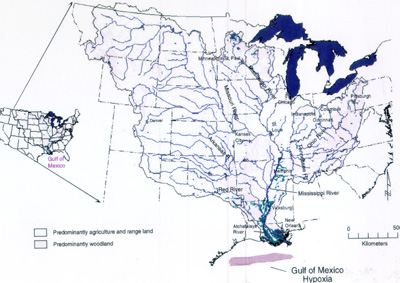
| To the previous article | To the next article |
Watersheds of the Mississippi, Ohio, and Missouri rivers encompass 40% of the area of the lower 48 states and span 30 states altogether, making up what is commonly known as the Mississippi River Basin. Of this area, over 58% is agricultural land that produces the majority of the corn, soybeans, wheat, cattle, and hogs grown in the United States. Due to intensive agricultural practices in the basin, the majority of the fertilizers and pesticides used in the U.S. are also in this region. Agriculture is a major source of nutrient influx to surface waters of the developed world. For example, in a study of the Mississippi Basin by Omernik (1977), total nitrogen concentrations were 9 times higher downstream of an agricultural area than a forested area with highest concentrations being found in the corn belt states of the Upper Mississippi basin. Other factors such as non-point source discharge from urban and suburban areas and point discharges from domestic wastewater treatment systems and feedlots contribute to nutrient enrichment of the watershed, but agricultural activities remain the dominant source of nitrogen and phosphorus enrichment of the water, contributing about 50% of the nitrogen levels found in the

 |